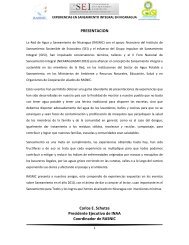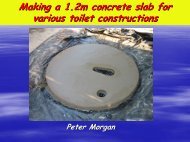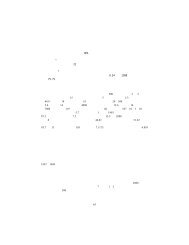Open Planning of Sanitation Systems
Open Planning of Sanitation Systems
Open Planning of Sanitation Systems
Create successful ePaper yourself
Turn your PDF publications into a flip-book with our unique Google optimized e-Paper software.
Elisabeth Kvarnström and Ebba af PetersensTable 2. Example <strong>of</strong> ToR for a low-cost sanitation system.Primary functionsHygiene and disease protectionAll parts <strong>of</strong> the system and subsequenthandling <strong>of</strong> products must achieve a high level<strong>of</strong> hygiene and disease protection, including:• High hygienic standard within the toilet,the washing area, and with regards togreywater/wastewater effluent, etc.• Excreta must be stored/disposed <strong>of</strong>without risk <strong>of</strong> seepage <strong>of</strong> pathogens to thegroundwater• It must be possible to manage collection anddisposal <strong>of</strong> waste products in a hygienicallysafe mannerWater Protection• Excreta must not be stored or disposed <strong>of</strong>so that there is a risk <strong>of</strong> leachate <strong>of</strong> nutrientsinto the groundwater• Surface waters (ditches, ponds, rivers,lakes) should be protected from nutrientsand organic matter originating from toiletsand greywater/wastewaterNatural resources conservation• Virtually all nutrients from the sanitarysystem (urine as well as faeces) shouldbe recycled to productive land, so as tominimise nitrogen losses within the system,pollution, etc.• The system (washing area etc.) should beconstructed in a way that allows collectionand recycling <strong>of</strong> waterPractical and economical aspectsEconomics• Investment costs should be reasonable• Households should be able to carry outoperation and maintenance in kindReliability• The technology must be robust, also duringextreme weather conditionsFlexibility• It should be possible to adapt the technologyto varying household sizes. The systemshould work without electricityUser aspects• The toilet should be inside the house• The system must be easy to use, includingfor children, women, and the elderly• Maintenance should be quick and easyResponsibility• Responsibilities <strong>of</strong> households andauthorities must be clearControl• It must be possible to evaluate the systemperformanceHygiene and disease protectionThe sanitation system, including black- and greywater and solid waste, should not causeunsanitary conditions or nuisances such as odours or insect infestation in any part <strong>of</strong> thesystem.The toilet should be easy to use and preferably be made <strong>of</strong> materials with a smooth surfaceto facilitate cleaning. Excreta must not be stored or disposed <strong>of</strong> in a manner resulting ingroundwater contamination by pathogens. Therefore, an elevated collection tank is preferablefor dry systems (SMI, 2004).Handling <strong>of</strong> waste products, i.e. treated greywater, urine, faeces, sludge etc. should bepossible to accomplish in a hygienic way, using appropriate procedures and equipment, suchas wearing gloves and good hand-washing practices (SMI, 2004).Recycling <strong>of</strong> waste products must be hygienically safe. This means that fresh faecesespecially, which may contain large numbers <strong>of</strong> pathogens, must be treated before recycling.Suitable methods <strong>of</strong> treatment are long-term storage, composting and the addition <strong>of</strong> ash andlime. On a municipal scale, secondary treatment for faeces in larger systems may includealkaline treatments, composting and incineration (SMI, 2004). For urine, storage for a certain8



![Project Document [PDF: 2.31 MB] - EcoSanRes](https://img.yumpu.com/51279385/1/184x260/project-document-pdf-231-mb-ecosanres.jpg?quality=85)












![Latrines à compost [high-resolution colour PDF: 12.3MB] - EcoSanRes](https://img.yumpu.com/31726141/1/185x260/latrines-a-compost-high-resolution-colour-pdf-123mb-ecosanres.jpg?quality=85)